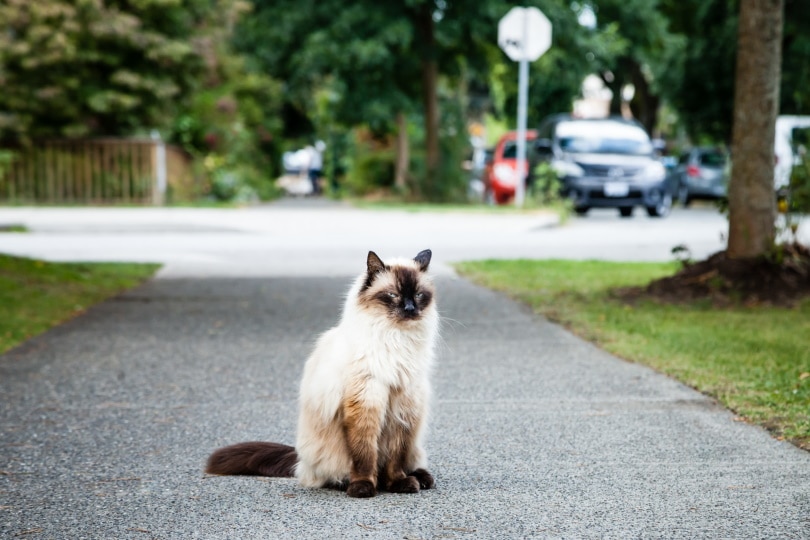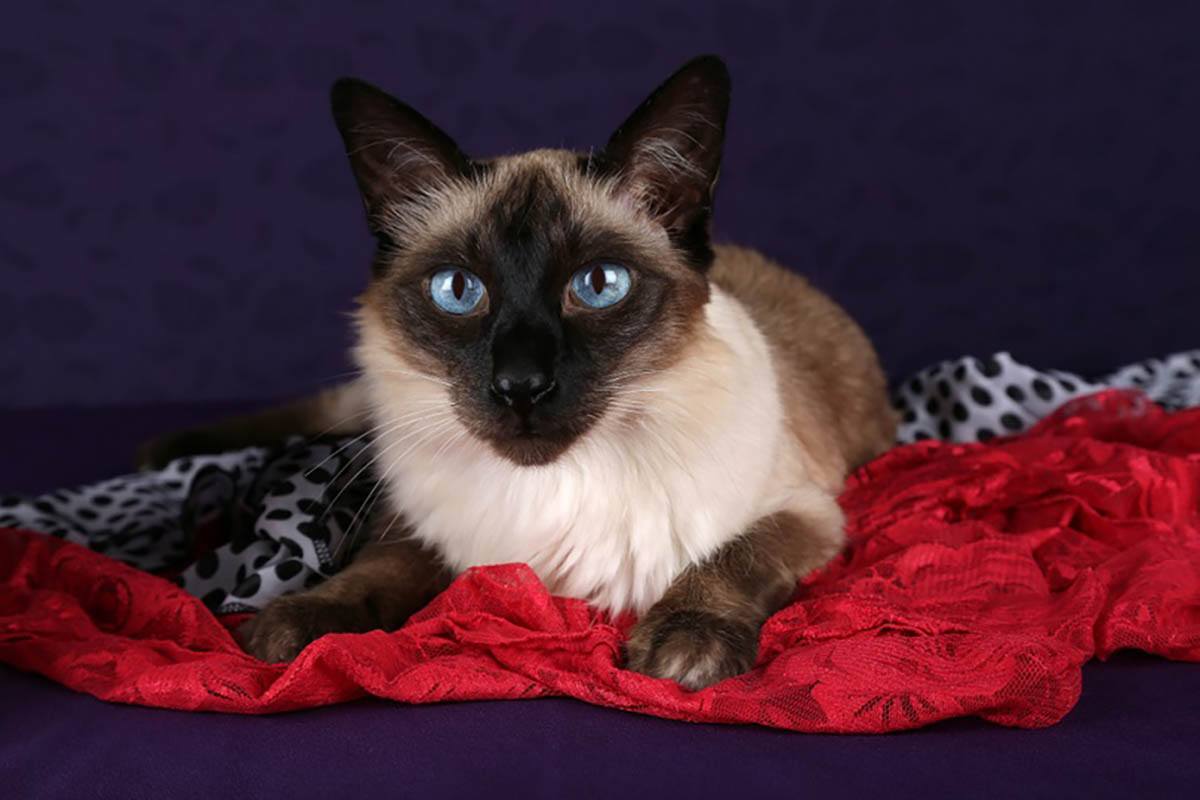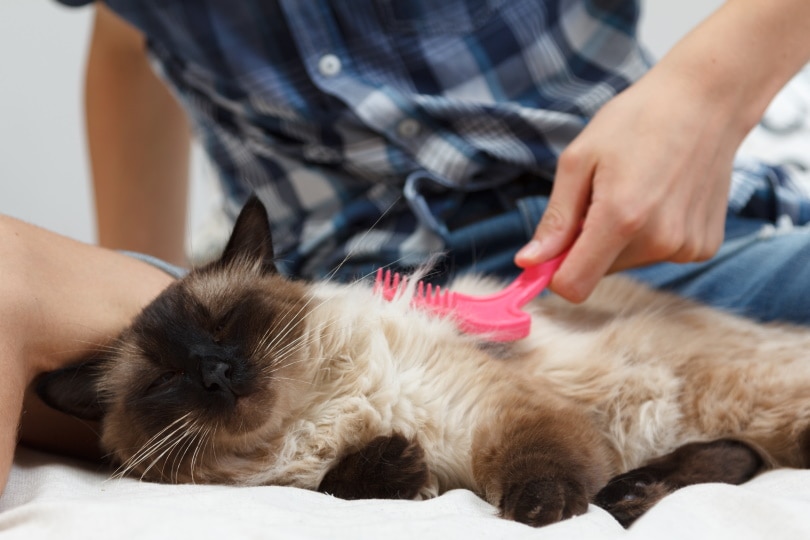
The majestic and graceful Balinese cat is closely related to the Siamese. Their long, elegant coat and fine-boned body, combined with sparkling blue eyes, are reminiscent of royalty. However, these cats are curious and happy to rescind their royal crown to engage in play sessions or cuddle with their owners, making them wonderful pets.
Unfortunately, they have many of the same health issues as Siamese cats. Most of these issues are genetically inherited, so it’s important to get kittens from a reputable breeder who provides a health guarantee. Other concerns are preventable and treatable, so it’s important to know what kinds of illnesses your cat is predisposed to. Read on for a list of Balinese cats’ possible health concerns.

The 8 Health Concerns for Balinese Cats
1. Convergent Strabismus and Nystagmus
| Preventable: | No |
| Genetically Inherited: | Yes |
| Severity: | Minor |
| Treatment: | No treatment is required |
Convergent strabismus is the term that medical professionals use to describe crossed eyes. In most cases, crossed eyes are considered a birth defect, but it’s considered normal in Balinese cats. Some Balinese cats are also born with nystagmus, a condition that causes their eyes to flick back and forth.
Despite these eye conditions, neurological studies on Balinese cats have shown that they do not have double-vision. The brain compensates for the defect and sorts visual information so the cat sees a single image, just like any “normal-eyed” cat would. This means it is not a serious condition, and no treatment is needed. Most owners come to find the uniqueness of their cat’s eyes endearing over time!
2. Amyloidosis
| Preventable: | No |
| Genetically Inherited: | No, but genetic predisposition to developing the disease |
| Severity: | Severe |
| Treatment: | Diet and medication support, no cure |
Amyloidosis is a condition that occurs when proteins called “amyloids” get deposited in various organs and tissues, leading to organ dysfunction. The condition is uncommon in cats, but Balinese cats are genetically predisposed to developing it. It has been traced to certain family lines, but there is no clear profile to determine whether a specific cat will get the condition or not.
Symptoms of amyloidosis vary depending on which organ system is affected, but it is most commonly the kidneys. Initial symptoms include appetite loss, lethargy, increased drinking and urination, weight loss, vomiting, and diarrhea. In rare cases, fluid builds up under the skin, chest cavity, or abdomen. In Balinese cats, the liver can also be affected. This can cause hepatic rupture and severe internal bleeding.
The cause of amyloidosis isn’t totally clear. Chronic inflammation and infection are thought to play a role in the development of the disease. However, there must be a family predisposition present. Unfortunately, there is no cure for amyloidosis. The condition can often be stabilized with hospitalization and IV fluids. Some cats can tolerate management at home with dietary changes and supportive medication. Some cats develop secondary hypertension, or high blood pressure, which also requires medication.
A diagnosis of amyloidosis is devastating, but the progression of the disease depends on the severity. In cats that enter kidney failure, the survival time is often less than 1 year. The prognosis is good for those mildly affected, and with proper management, such cats can live out their normal lifespan.

3. Progressive Retinal Atrophy
| Preventable: | No |
| Genetically Inherited: | Sometimes |
| Severity: | Moderate |
| Treatment: | None available |
Progressive retinal atrophy, or PRA, leads to the degeneration of cells in the retina. This part of the eye reacts to light and sends visual information to the brain. For cats, PRA can be acquired or inherited.
In the case of the Balinese cat, certain genetic lines carry the gene for PRA. In order for the cat to be affected, they must inherit two copies of the gene mutation (one from each parent). Breeders who are conscious of genetic testing can actually “breed out” the gene for this condition and prevent it from being passed on to future offspring.
As the name suggests, PRA is a progressive disease. Over time, the photoreceptor cells in the retina deteriorate and cause vision loss. Night-time blindness starts first. Eventually, it will cause blindness over a period of 2 to 4 years.
While there is no treatment for PRA, it’s important to understand that most cats can live long, happy lives, even if they go blind. Cats spend most of their time in one place; they don’t need to read, drive, or travel the way that humans do. That said, there are a few adaptations that need to be made when living with a blind cat:
Cats can adapt quickly to their lack of vision and enjoy a full life.
4. Separation Anxiety Syndrome
| Preventable: | Sometimes |
| Genetically Inherited: | No |
| Severity: | Mild to severe |
| Treatment: | Training, medication, socialization |
While many cats prefer a solitary lifestyle, some Balinese cats can develop unhealthy attachments to their owners, leading to separation anxiety. When their owners aren’t present, these cats become bored or anxious and exhibit destructive behaviors, such as:
While these behaviors can be frustrating, there are ways to minimize separation anxiety in cats:
For more severe cases of separation anxiety, there are medication options. Some veterinarians will recommend using calming techniques or treats and pheromones before prescribing medication. If you are experiencing behavioral problems with your cat, it is always advised to speak with your vet about how to best treat the problem.

5. Wool Sucking
| Preventable: | No |
| Genetically Inherited: | No |
| Severity: | Minor |
| Treatment: | No treatment is required |
Wool sucking refers to a cat’s inclination to suck on soft material long after they have left their kitten stage. Balinese cats are prone to sucking behavior with items like soft blankets, fabric, and sometimes even their own tails. The behavior is thought to be self-soothing, much like a baby sucking their thumb.
Wool sucking is not dangerous, and there is no need for treatment, although it may create extra laundry! For cats that develop compulsive sucking behavior, high-fiber dry foods can help stop the problem, as can using puzzle feeders to encourage “foraging” for food.
Ensuring that your cat gets plenty of exercise, attention, and playtime can also help cats feel more at ease. Cat-proofing the house for when you aren’t home will prevent your cat from sucking on items that they shouldn’t.
6. Cardiomyopathy
| Preventable: | No |
| Genetically Inherited: | Yes |
| Severity: | Moderate to severe |
| Treatment: | Medication |
Hypertrophic cardiomyopathy (HCM) is the most common form of heart disease in cats. Balinese cats are genetically predisposed to develop the condition, which causes the walls of the heart to thicken, making it harder to pump blood throughout the body.
The effects and prognosis of the disease vary significantly. Proper diagnosis is key to improving the cat’s quality of life and managing symptoms.
Although there is no cure, oral medication can be prescribed to manage HCM. In more severe cases, injections may be required, along with the use of topical medications like nitroglycerin. HCM is a progressive disease, but medical management can improve a cat’s quality of life and longevity in most cases.

7. Lymphoma
| Preventable: | No |
| Genetically Inherited: | No |
| Severity: | Serious |
| Treatment: | Medication, chemotherapy |
Balinese cats are more prone to developing feline lymphoma than other breeds. With early diagnosis, cats can receive treatment. Symptoms of lymphoma depend on where the tumor is growing. Lymph nodes will show swelling in the neck, shoulders, and knees. Lymphoma in the chest will cause respiratory symptoms. In some cases, cats will develop neurological symptoms, like walking difficulties or behavioral issues if the lymphoma affects the nervous system.
Treatment for lymphoma usually involves chemotherapy. Steroid treatments may also be given and can help prolong a cat’s life. Lymphoma is often caused by FeLV and FIV. The FeLV virus is preventable through vaccination.
8. Cat Gangliosidosis
| Preventable: | No |
| Genetically Inherited: | Yes |
| Severity: | Fatal |
| Treatment: | None |
As relatives of Siamese cats, Balinese may inherit the genes for this lysosomal storage disease. It is a genetic inability to metabolize certain lipids normally. They build up within cells and disrupt their normal function. Symptoms of difficulty walking may start around 1 to 4 months of age and progress until the cat passes away, usually before one year old.


Conclusion
Balinese cats make wonderful companions, but they are genetically predisposed to the development of several health conditions. While some aren’t preventable, others can be avoided by ensuring that you get your cat from a reputable breeder. Health testing is a good idea for cats that carry genetic conditions, and like most medical diagnoses, the earlier that you catch them, the better. If you have questions or concerns about the health status of your Balinese cat, speak with your veterinarian about what you can do to help your cat live the healthiest life possible.
See also:
- Osteosarcoma in Cats: Signs, Treatment & Care (Vet Answer)
- 10 Best Toys for Blind Cats — Reviews & Top Picks
Featured Image Credit: SJ Duran, Shutterstock






